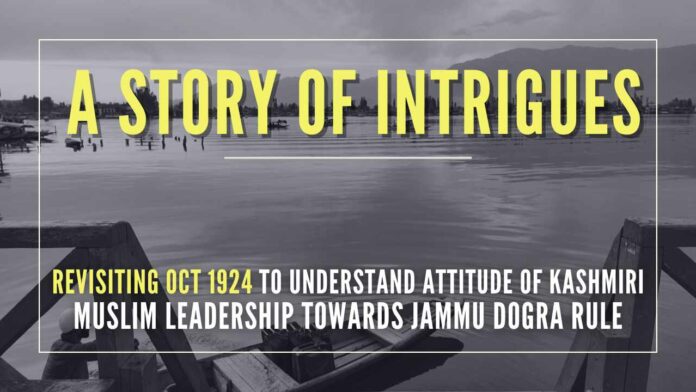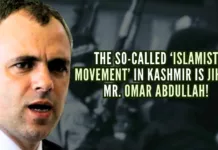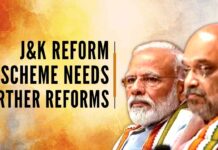
Analysis of the mindset of Kashmiri Muslim leadership towards Jammu Dogra rule
In October 1924, Lord Reading, Governor General, and Indian Viceroy visited Srinagar. Kashmiri Muslim leaders took this as an opportunity to further paint the Jammu Dogra rule and the Hindus’ black, cruel, discriminatory, and alien(s) and dislodge the Dogra rule. His arrival in Srinagar made the Muslims “rejoice”. They submitted as many as six memorandums to him. They alleged that the Muslims of Kashmir were being oppressed under untold tyrannies; that they arranged extensive demonstrations to show their dissatisfaction against the Hindu rule; and that this never suited the “autocratic policy of the Darbar”. “They suppressed any voice being raised. Even certain respectable Muslims, who were appointed, were threatened with punishment should their co-religionists raise a single voice. Their rights had been trampled, their privileges denied and their peaceful requests controverted by military attacks and their representations labelled as seditious. They must naturally vent their feelings, especially when they see the Ex-Lord Chief Justice of the British Empire coming as if sent by God…The voice was raised and demonstrations were made…Such was the state of affairs…,” alleged one of the petitions[1].
The point in short is that the Kashmiri Muslim leaders through their petitions alleged that “oppression was being practiced upon the 12 lakh Muslims of Kashmir probably to convert them to the Hindu religion”; that “their Islam was being dishonoured and insulted”; that “attacks were being made on the holy places of Islam”; that “they were deprived of facilities in education and were not allowed any hand in the administration though they alone filled the coffers of the state”; that “we are sure that the moment Your Excellency will depart from the country (J&K state), the bigoted Hindu administration together with their instruments, Kashmiri Pandits, will treat us worse and practice all possible tyrannies over us”[2].
The petitioners requested Lord Reading to institute an inquiry commission to “look into the oppression practiced by the Hindus”. They demanded that the “commission consisted of either non-officials or Europeans”. They went to the extent of calling Lord Reading “God sent to hear grievances and to redress our wrongs” and asking him to “make the (British) Resident in Kashmir responsible for the safeguards of their interests and rights”[3]
It needs to be underlined that the Muslim leadership while presenting the memorials failed to realize that for the past forty years (1889-1921) the machinery of administration had been in the hands of the British Indian government. (in 1889, Maharaja of J&K, Pratap Singh, was deposed by the British government on fictitious charges. He was given back some of his authority only in 1921.) Their grievances, imaginary or otherwise, were the deeds of the British rule, and not of the Dogra Maharaja, who was a Maharaja only in name. That the allegations against the Maharaja and the Hindus were imaginary could be seen from the remarks of the Resident in 1924, J B Wood. He asserted that “the petitions or memorials contained some obvious misstatements and exaggerations” and remarked that “as far as his information goes, there are no such grievances on the part of the memorialists as would justify him in making a representation to the Darbar (read J&K government)[4]. At the same time, however, Wood, under the instructions of the British Indian government, demanded from the State Council (read State Council of Ministers) a report of the facts relating to the charges levelled by Kashmiri Muslims against Pratap Singh and his government[5].
As a result, on October 27, 1924, J&K Foreign Minister, Hari Singh, who in 1925 became Maharaja of J&K, submitted a memo in the State Council relating to six petitions submitted by the Muslims. As the alleged grievances covered a great amount of ground and dealt with a large variety of subjects relating to almost all the state departments, Hari Singh thought it prudent to discuss all the main points in these memorials in a special meeting of the State Council[6]. Ultimately, on October 30, 1924, the State Council appointed a three-member sub-committee with Revenue Member (read Revenue Minister) as its convener and Public Works Member, and Finance and Police Members as its members mandating it to submit a report to the Council on the general situation[7].
The sub-committee did not consider it necessary to deal individually with each case of the several representatives, some of which were of an “anonymous” nature because the alleged grievances that they pinpointed were all set forth in one memorial No. 5 dealing exhaustively with every variety of complaints and disabilities on the part of the Kashmiri Muslims. Memorial No. 5 had been presented by Maulvi Ahmad Ullah, Mirwaiz Kalan, Mirwaiz Hamdani, Maulvi Atiq Ullah, Khawaja, Hassan Shah Naqshbandi, Khawaja Sad-ud-Din Shawl, Sayyad Hassan Shah Jalali, Maulvi Sharief-ud-Din, Sayyad Shaid Shah Jalali and Haji Zafar Khan.
The sub-committee summoned each of these individuals to appear and explain the contents of their representation. Many of them appeared and recorded their statements. The findings of the committee made the members conclude that the allegations contained in the portion of the memorials were “exaggerated” and that they were “couched in the most improper and objectionable manner”. However, the committee admitted that the “proportion of Muslim officials in the state was small”, but observed that “it was due to the difficulty of finding suitable candidates which prevailed, though to a lesser extent, also in British India”. The committee further observed that the number of Muslim employees was gradually being increased, but until the Muslim community took full advantage of the educational facilities which the Darbar provided, it was unreasonable to expect the state to take Muslims into service in proportion to their population”. However, the committee asked the signatories to the petitions to “bring to their notice specific complaints of corruption or prejudice on the part of the state officials”.
It needs to be noted that the complaint of the Kashmiri Muslims that their number in government service was “rather low” was untenable. This was the case, for instance, in regard to the Police and Accounts Departments as the petitioners themselves admitted and it appeared from the statements of some of them that “the statistics were supplied by Sad-ud-Din Shawl and were blindly accepted”. As regards the Revenue Department, the assertion that “even the orderlies, jamadars and peons are almost all Hindus” was nothing short of “grotesque”. The petition sought to create an impression that “apart from one member of the State Council, Muslims were debarred from holding high positions in the state”. It will be only desirable to mention a few instances to refute this contention. Of the two Chief Judges in the state, one was a Muslim. Of the two superintendents of police, one was a Muslim. The highest Indian official in the settlement department was a Muslim. One Muslim official was the head of the cooperative department. In the revenue department, there were many Muslims holding important positions. For instance, in Kashmir province, two out of three Wazir-e-Wazarats (officials below the rank of Provincial Governor) were Muslims.
One of the allegations against the government of Maharaja Pratap Singh was that the “Kashmiri Pandits were regarded as beyond the reach of the law”. The petitioners, when called upon to substantiate the charge, failed to “adduce any instance in support of their allegations that Pandits were beyond the reach of law while the Muslims were victimized with impunity”.
As regards education policy, the petitioners acknowledged before the sub-committee “inaccuracies in their statements that the teachers in schools are all Hindus” and that “no scholarships for training in India” had “been awarded by the Darbar to Muslims”. In fact, the petitioners could adduce nothing in the nature of proof that “Muslim students were discouraged as such from attending academic institutions in the state”.
With regard to the emergence of dissension between the two communities and disloyalty to the Maharaja and his government, the sub-committee observed that “this had been fostered to a large extent by agitators from British India”. “There are reasons to believe that certain Khadims of the state Hamadan Shrine and other persons after visiting British India had returned to Kashmir and disseminated the idea that the Viceroy was visiting the state in order to ‘displace the Hindu dynasty and establish Mohammedan rule’. It may not be astonishing that such ‘idle rumours should be credited by the uneducated masses’. It was clearly the duty of those who professed to regard themselves as leaders to discourage their followers from entertaining any such illusion,” the sub-committee, in addition, observed.
Finally, the sub-committee expressed the view that “the Muslim interests had not in any way suffered and the ‘Darbar have shown no prejudice against their Mohammedan subjects, nor they have any intention of departing from the strict observance of impartiality in future”.
The sub-committee in their recommendations pinpointed that the main “ring leaders” behind the episode were Sad-ud-Din Shawl and Hassan Shah Naqshbandi and recommended that Sad-ud-Din Shawl be “expelled from the state and should not be allowed to return until and unless he is permitted to do so by His Highness-in-Council”. Regarding Hassan Shah, the sub-committee noted that “the leading part played by Hassan Shah Naqshbandi in this disloyal movement was the most reprehensible because ‘his family has long enjoyed and continue to enjoy the benefit of a Jagir granted to them by the Hindu ruler”. The committee recommended that “Hassan Shah Naqshbandi’s share in this Jagir should be forfeited”.
Maharaja Pratap Singh accepted the recommendations with “great pain”. He made it clear that “he has always been and will always be my aim to deal impartially with classes of my people whose welfare is very dear to my heart”[8].
Did the action against the anti-state and anti-Hindu forces in Kashmir change the situation? Sadly, the answer is a big NO. Rather, things further worsened in Kashmir. The Kashmiri leaders and their supporters in British India — the All India Mohammedan Educational Anglo-Oriental Educational Conference; the Kashmiri Conference; Anjuman-i-Kashmiri Mussalmans, Lahore; the Anjuman-i-Islamia, J&K; the Anjuman-i-Islamia, Lahore; the Khilafat Committee, Lahore; the British-India-based Press, including papers and magazines like The Siyasat, The Muslim Outlook and the Kashmiri Magazine – not only urged Maharaja Pratap Singh to withdraw his orders under which Sad-ud-Din Shawl was expelled from Kashmir and the Jagir of Hassan Shah Naqshbandi confiscated[9], but again and again asked the British Indian government to appoint another inquiry commission[10], and end the Dogra rule in J&K or take over J&K or abrogate the March 1846 Treaty of Amritsar under which Kashmir had become part of the Dogra Kingdom. Things in Kashmir worsened all the more with the rise of Sheikh Abdullah and his Muslim Conference in the early 1930s. He was backed to the hilt both by the British Indian government and J L Nehru. Emboldened as he was, Sheikh Abdullah launched the “Quit Kashmir Movement” against the Dogra Maharaja and the Dogras of Jammu in 1946.
Put in any amount of effort to find if the Kashmiri Muslim leadership ever adopt a positive approach towards the Dogra rule and the Hindus of J&K between 1846 — when J&K State came into being — and October 1947 – when Nehru handed over the whole of Jammu, Kashmir, and Ladakh or transferred the state power from Jammu to Sheikh Abdullah using surreptitious means — and towards India and the Indians, you will come out of the exercise minus everything. Their attitude always remained hostile towards the Dogra rule, Hindus of J&K and India, and the Indians. The only difference is that they demanded separation of Kashmir from Jammu between 1846 and 1947 and they have been demanding separate status for Kashmir and a dispensation that empowers them to exercise absolute, unbridled, and extraordinary legislative, executive, judicial, and financial powers and misrule, exploit and drain Jammu and Ladakh since October 1947.
Narendra Modi’s government did well on August 5, 2019, to abrogate Articles 35A and 370 and create two UTs out of J&K – UT of Ladakh and UT of J&K – to break the backbone of Kashmir jihad. However, it’s not enough. The Modi government has to take four more steps to achieve the desired results. It has to separate Jammu from Kashmir and grant it statehood status, convert Kashmir into a Chandigarh-type UT, create a separate homeland for the persecuted and internally-displaced Kashmiri Hindus within Kashmir, and overhaul the J&K administrative set-up and administrative machinery. These steps alone would help the Modi government to bring the secessionists and communalists in Kashmir to India’s knees.
Note:
1. Text in Blue points to additional data on the topic.
2. The views expressed here are those of the author and do not necessarily represent or reflect the views of PGurus.
Note:
1. Text in Blue points to additional data on the topic.
2. The views expressed here are those of the author and do not necessarily represent or reflect the views of PGurus.
References:
[1] From Muslim public to Lord Reading, Governor General, Oct. 1924, JK Gen Deptt. File No. 524/F.62 of 1924, State Archives Repository Jammu
[2] Ibid.
[3] Ibid.
[4] From JB Wood to Hari Singh Foreign Minister, D.O. No. 5072, dated 16-17, Oct 1924, Ibid.
[5] Ibid.
[6] Memo (Confidential) Foreign Deptt. No. 1740, dated Oct. 27, 1924, JK Gen Deptt File No. 529/R.62 of 1924)
[7] Extract from Confidential proceedings NO. 5-C of the State Council, dated Oct. 30, 1924, JK Gen Deptt File No. 524/F.62 of 1924
[8] Proceedings of the Committee and Order No. 96-C, JK Gen. Deptt. File No. 524/F-62 of 1924
[9] Copy of letter No. 879/A, dated 14.7.1925, from Mohd. Ali Khan, President, Anjuman-i-Islamia, Punjab, Lahore, to Hari Singh, Ibid.
[10] Copy of letter No. 19085 dated 21.8. 1925 from the Editor, The Muslim Outlook, Lahore, to Private Secretary to Foreign Minister Hari Singh, Ibid.
PGurus is now on Telegram. Click here to join our channel and stay updated with all the latest news and views
For all the latest updates, download PGurus App.
- ‘Kashmir My core constituency’: Revisiting July 12, 2003 to understand politics, Omar Abdullah-style - March 15, 2024
- Total deviation from traditional approach: Seven takeaways from PM Modi’s March 7 Srinagar visit - March 9, 2024
- Status of political parties: Why is further J&K reorganization imperative? - March 1, 2024











Kashmir was a partially successful land grab by the Abdullas, Nehrus and western educated Kashmiris from the Bureaucracy. The state was sought to be captured and kept under their own control with 370 and 35A in placed, ensuring the finances came form the Indian Taxpayer. Unfortunately even before the loot could become secure the greed had better of the gangs, so they kicked Pandits out with the help of Pakistan. Nobody will shoulder the Indian Tricolor, blood will flow on the streets was the confidence of the Gupkar gang before the land grab failed.